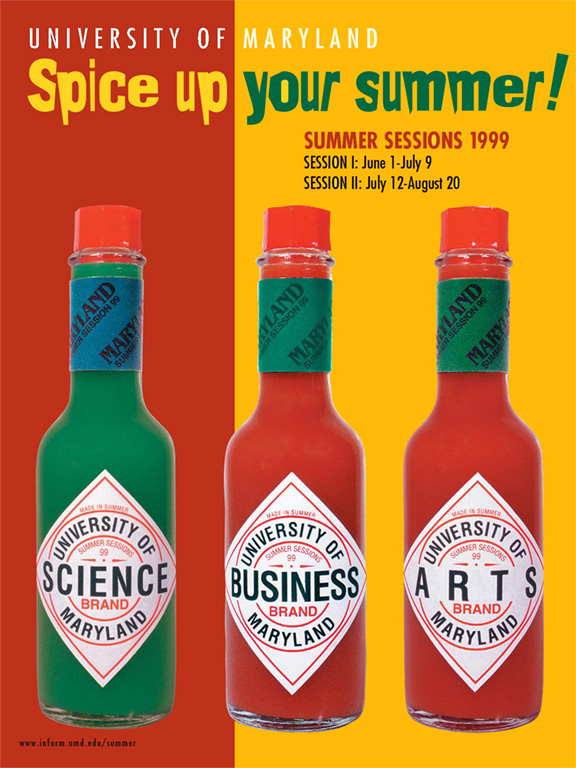AURAS produced the marketing for the University of Maryland Summer Programs for several years, including posters, catalogs, and ads. Each year we proposed several themes, and they chose the campaign. The third year they chose the theme “Spice Up Your Summer,” which featured three bottles of hot sauce labeled Science, Business, and Arts. They all thought it was a clever parody of the Tabasco bottles. We designed and printed the catalog and posters. Then the shit hit the fan.

Lawyers from the McIlhenny Company, the makers of Tabasco, sent the university a cease-and-desist order, demanding UM to remedy the offending “trademark violation” by destroying all of the materials. The Summer Programs director was apoplectic about the unsigned, unnotarized letter—not at them, but at AURAS. I explained about Fair Use Doctrine and parody and that we actually hadn’t used any of their trademarks. I assured them that the letter was a bluff to protect their intellectual property by attacking anything that resembled a use of their trademarks.
I wrote a letter back to the lawyers protesting their order (which was not a legal document in any way, just a threatening letter on their letterhead), insisting that there was no use of their trademarks. According to my lawyers, even if there was, this was clearly within the bounds of fair use. I soon received a call from one of their lawyers. He said, of course, he agreed with me but that the real issue was with the “trade dress.”
Trade dress lawsuits happen when a company creates a competing product and then packages it to look like another (more popular) brand, trying to trick consumers into believing they are getting something they are not. It’s a way of skirting all the arguments about fair use. It’s a mystery how our art could possibly dupe a college student into expecting bottles of Tabasco sauce instead of summer school, but a simple internet search revealed that using trade dress as a legal argument when there was no competing product never worked in court. But the lawyer I spoke to said the equivalent of, “Go ahead and fight this—if you can afford it.” If steam came out of people’s ears, it would have come from mine.
Regardless, the redress for copying trade dress was surrendering the profits gained from the deceptive use. Since there was no product and no profit, and the catalog and posters would be up for 45 days, far shorter than any law action would take, I argued again for the program director to ignore the whole thing. But then the University President called and yelled at me for getting her in this “predicament” and demanded I fix it and pay for all the costs.
If I had had an ounce of guts, I would have indemnified the university and taken responsibility. I was 99.9 percent sure I was legally correct—and I was pissed. The whole thing would probably evaporate if it were just left alone, and I would be proven right. Instead, considering the unknown extent the company might go to prosecute the offense, we took the cowardly route of caving and offered to remake the art. We replaced the bottle with a cheap clip-art of a chili pepper.
The McIlhenny lawyers then contended their trademark extended to anything that even looked like a chili pepper. The program director finally had enough jerking around from the lawyers and told them that was ridiculous, so we used the art.
However, we had already printed the catalog with the hot sauce bottles, so we agreed to insert a sticker into each copy — all ten thousand of them — noting, “the use of Tabasco® branding was courtesy of the McIlhenny Company.”
The final indignity was a bill sent to the university for $9,000 for a lawyer to come to the campus for one day to check on compliance — from Virginia. The university wanted us to pay for the bill, but I refused and told them not to pay a cent. They compromised with the firm for a thousand dollars. After that, we never worked with the University of Maryland again — or any other area universities. No one would say, but I have always felt AURAS was blacklisted.
After that debacle, you’d think we would have learned our lesson, but a few years later, we created a pro bono campaign called “The Greatest Food on Earth” for a food-tasting charity event. We naively thought that Ringling Brothers would be thrilled to work with Share Our Strength to provide food to the hungry and invited them to participate as a sponsor. Instead, we got a threatening letter from their lawyers about using the phrase. Despite repeatedly losing in court, Ringling Brothers seemed to think that they owned every possible variation of “The Greatest [BLANK] on Earth.” Of course, SOS had a fit, not at them, but at us, even though they had vetted the concept. So, there we were the day of the event, stuffing all the programs with a little insert that said, “The use of trademarks owned by Ringling Brothers are generously provided by the company.”
As I have always said of Ringling Brothers, they’re “The Biggest [BLANKS] on Earth.”